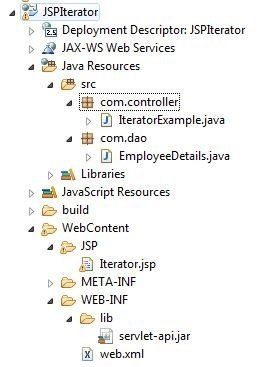In this example, a user requests to display employee’s data belonging to an organization on a UI (JSP). This example uses the MVC architecture. Following steps summarizes this example.
- The JSP contains a link to request for the employee data (View)
- The request is sent to a Java servlet (Controller)
- The servlet calls a DAO class to execute the business logic. In our case, it is to fetch employee data (Model)
- The request again sent to the JSP to display the employee data. The data is held in the ArrayList here.
- Next, display ArrayList elements using Iterator in JSP.
The following image explains the files/classes used in this example. Do note that, you would need servlet-api.jar to add dependencies for the Java servlet. We are using the Eclipse Integrated development environment(IDE) for this example. You can get one for free from here. To begin with, go to File > New > Dynamic Web Project

Suggested Read:
<%--Iterator.jsp --%>
<%@ page language="java" contentType="text/html; charset=ISO-8859-1"
pageEncoding="ISO-8859-1"%>
<!DOCTYPE html PUBLIC "-//W3C//DTD HTML 4.01 Transitional//EN" "http://www.w3.org/TR/html4/loose.dtd">
<html>
<head>
<meta http-equiv="Content-Type" content="text/html; charset=ISO-8859-1">
<title>Insert title here</title>
</head>
<body>
<%@page import="java.util.ArrayList"%> <%--Importing all the dependent classes--%>
<%@page import="com.dao.EmployeeDetails"%>
<%@page import="java.util.Iterator"%>
<% ArrayList<EmployeeDetails> employeeList = (ArrayList) request.getAttribute("EmpList"); %> <%--Assigning ArrayList object containing Employee data to the local object --%>
<strong><a href="<%=request.getContextPath()%>/IteratorExample?type=getDetails">Show Employee Details</a></strong>
<br></br>
<table cellspacing="2" cellpadding="2">
<tr><th>Employee ID</th><th>Employee Age</th><th>Employee Name</th><th>Employee City</th></tr>
<%
// Iterating through subjectList
if(request.getAttribute("EmpList") != null) // Null check for the object
{
Iterator<EmployeeDetails> iterator = employeeList.iterator(); // Iterator interface
while(iterator.hasNext()) // iterate through all the data until the last record
{
EmployeeDetails empDetails = iterator.next(); //assign individual employee record to the employee class object
%>
<tr><td><%=empDetails.getEmployeeID()%></td>
<td><%=empDetails.getEmployeeAge()%></td>
<td><%=empDetails.getEmployeeName()%></td>
<td><%=empDetails.getEmployeeCity()%></td>
</tr>
<%
}
}
%>
</table>
</body>
</html>
IteratorExample.java
//IteratorExample.java
package com.controller;
import java.io.IOException;
import javax.servlet.ServletException;
import javax.servlet.http.HttpServlet;
import javax.servlet.http.HttpServletRequest;
import javax.servlet.http.HttpServletResponse;
import com.dao.EmployeeDetails;
public class IteratorExample extends HttpServlet {
private static final long serialVersionUID = 1L;
protected void doGet(HttpServletRequest request, HttpServletResponse response) throws ServletException, IOException {
System.out.println("Inside Servlet");
String type = request.getParameter("type");
if(type.equals("getDetails"))
{
EmployeeDetails empDetails = new EmployeeDetails(0, 0, type, type);
empDetails.getEmployeeDetails();
request.setAttribute("EmpList", empDetails.getEmployeeDetails());
request.getRequestDispatcher("JSP/Iterator.jsp").forward(request, response);
}
}
}
The following class EmployeeDetails.java pushes the employee data into the arraylist object. Please note that you can also use a database connection to read employee data and assign it to the arrayList object. You can also make use of JavaBeans to play with the employee attributes. You can go through the following links to understand how you can connect to a database and use JavaBeans. Login application in Java and Registration application in Java.
//EmployeeDetails.java
package com.dao;
import java.util.*;
public class EmployeeDetails {
private int employeeID;
private int employeeAge;
private String employeeName;
private String employeeCity;
//Parameterized Constructor
public EmployeeDetails(int id, int age, String name, String city)
{
this.employeeID = id;
this.employeeAge = age;
this.employeeName = name;
this.employeeCity = city;
}
public int getEmployeeID() {
return employeeID;
}
public int getEmployeeAge() {
return employeeAge;
}
public String getEmployeeName() {
return employeeName;
}
public String getEmployeeCity() {
return employeeCity;
}
public ArrayList<EmployeeDetails> getEmployeeDetails()
{
ArrayList<EmployeeDetails> empList = new ArrayList<EmployeeDetails>();
empList.add(new EmployeeDetails(1, 20, "Ram", "Delhi")); //Adding employee data to the ArrayList object via parameterized constructor
empList.add(new EmployeeDetails(2, 30, "Raj", "Mumbai"));
empList.add(new EmployeeDetails(3, 40, "Ron", "Pune"));
empList.add(new EmployeeDetails(4, 50, "Rob", "Belgaum"));
empList.add(new EmployeeDetails(5, 60, "Roy", "Bengaluru"));
for (EmployeeDetails s : empList) //Iterates as long as there are elements in the list.
{
System.out.print("ID, Name and City of the employee are : ");
System.out.println(s.employeeID + " " + s.employeeAge + " " + s.employeeName + " " + s.employeeCity);
}
return empList;
}
}
The web.xml contains the servlet information. This file gets loaded in the beginning when you run your project. This is also known as deployment descriptor. It can also contain additional tags to define the session interval, welcome file lists and many more.
<?xml version="1.0" encoding="UTF-8"?>
<web-app xmlns:xsi="http://www.w3.org/2001/XMLSchema-instance" xmlns="http://java.sun.com/xml/ns/javaee" xmlns:web="http://java.sun.com/xml/ns/javaee/web-app_2_5.xsd" xsi:schemaLocation="http://java.sun.com/xml/ns/javaee http://java.sun.com/xml/ns/javaee/web-app_2_5.xsd" id="WebApp_ID" version="2.5">
<display-name>Iterator Example</display-name>
<welcome-file-list>
<welcome-file>JSP/Iterator.jsp</welcome-file>
</welcome-file-list>
<servlet>
<description></description>
<display-name>IteratorExample</display-name>
<servlet-name>IteratorExample</servlet-name>
<servlet-class>com.controller.IteratorExample</servlet-class>
</servlet>
<servlet-mapping>
<servlet-name>IteratorExample</servlet-name>
<url-pattern>/IteratorExample</url-pattern>
</servlet-mapping>
</web-app>
The following image explains how the Employee data looks like on the UI dashboard (JSP).
